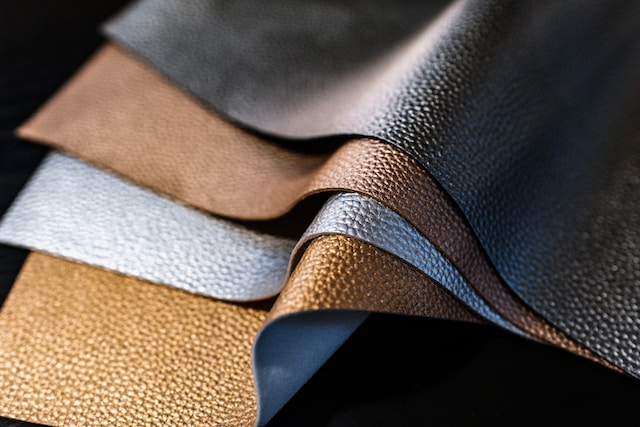Leather is a popular material used for a variety of products such as clothing, footwear, and furniture. However, the production of leather has a significant impact on the environment. It is essential to explore the negative effects of leather production and the need for sustainable solutions.
Brief Overview of Leather Production
Animal hides, particularly those of cows, lambs, and goats, are used to make leather. Cleaning, soaking, tanning, and finishing are some of the phases in the process of turning hides into leather. With millions of people engaged at various levels of production and sale, the leather sector makes a considerable contribution to the world economy.
The Impact of Leather Production on the Environment
The process of making leather raises a number of environmental issues, such as water pollution, deforestation, and greenhouse gas emissions. Water bodies are severely contaminated by tanneries’ wastewater discharges of hazardous compounds like chromium, sulfides, and heavy metals. Livestock production also contributes to deforestation and changes in land usage, which worsen the environmental impact.
The Need for Sustainable Solutions
Consumers are becoming more conscious of how producing leather affects the environment. Sustainable leather substitutes are in greater demand. The environmental effects of traditional leather manufacture are severe. The negative effects of leather production may be lessened with the use of sustainable solutions. Alternatives to leather that are more environmentally friendly are urgently needed.
The Environmental Impact of Leather Production
The ecology is significantly impacted by the production of leather, which has a number of detrimental effects. These consist of;
- Land clearing for animal rearing and the manufacture of leather results in extensive deforestation. Carbon emissions, not only result in habitat degradation but also influences climate change. Water contamination and depletion are two more significant effects of the leather industry.
- Large quantities of water are used throughout the production process, and this water is frequently contaminated with chromium and other harmful compounds. Wildlife, vegetation, and locals who depend on the water for their livelihoods may be harmed by this tainted water.
- The raising of cattle, shipping, and tanning procedures are the main sources of greenhouse gas emissions in the leather industry. These emissions lead to climate change, which affects the ecosystem greatly and causes things like rising sea levels, harsh weather, and the extinction of species.
- Another major worry is the use of hazardous chemicals in the manufacture of leather. Particularly when tanning, chemicals like chromium are used, which may have long-lasting consequences on the environment and human health. Considerable environmental concern is also posed by the waste produced during the production of leather, including sludge and other byproducts.
Overall, leather production has a significant negative influence on the environment that cannot be disregarded. In order to lessen these effects, the leather industry needs more environmentally friendly production techniques and sustainable alternatives to traditional materials.
Sustainable Alternatives to Traditional Leather
Here you go with the sustainable alternatives to traditional leather;
1. Plant-Based Leather Alternatives
Natural resources including mushrooms, pineapple leaves, and apple skins are used to create plant-based leather substitutes. These materials are processed without the use of hazardous chemicals and in an environmentally friendly manner, making them a viable substitute for conventional leather.
a. Mushroom Leather
Mycelium, the mushroom’s root system, is used to create mushroom leather. It is a robust and long-lasting material that can be used to create many different products, like shoes, handbags, and jackets. Mushroom leather can be composted at the end of its life and is biodegradable, making the manufacturing process environmentally benign.
b. Pineapple Leather
The fibers of pineapple leaves are used to create pineapple leather, also known as Piatex. It is a flexible, supple substance that resembles typical leather in texture. Compared to traditional leather, pineapple leather is manufactured in a waste-free manner and has less carbon footprint.
c. Apple Leather
Apple peel and core scraps are used to make apple leather. It is a flexible material that is lightweight and strong and can be utilized for many different goods. The waste generated during the production of apple leather is recycled and used again thanks to closed-loop technology.
2. Recycled Leather Alternatives
Alternatives to leather that have been recycled are created from leftover leather scraps and offcuts. These materials can be processed sustainably and without the need for additional resources, making them a viable choice for fashion manufacturers.
a. Upcycled Leather
Waste leather from industries is collected and used to create new products using upcycled leather. It is a resource-saving and environmentally responsible replacement for conventional leather that decreases waste.
b. Reclaimed Leather
Reclaimed leather is created by using old leather clothing and furnishings. Cleaning and processing are done to the leather to produce a fresh material that may be applied to many different goods like leather jackets and pants etc. Traditional leather can be replaced with recycled leather, which is more resource- and waste-efficient.
3. Synthetic Leather Alternatives
Reclaimed leather is created by using old leather clothing and furnishings. Cleaning and processing are done to the leather to produce a fresh material that may be applied to many different goods. Traditional leather can be replaced with recycled leather, which is more resource- and waste-efficient.
a. PU Leather
A synthetic substance that resembles traditional leather in texture is called PU leather. It costs less to create and uses fewer resources than regular leather. PU leather is a well-liked substitute for genuine leather in items like shoes and purses.
b. PVC Leather
Compared to genuine leather, PVC leather is a synthetic material that uses fewer resources to make. It is a reliable and cost-effective substitute for traditional leather, which is frequently used for goods like furniture and automotive interiors.
Ending Notes
Consequently, the fashion industry is quickly changing to satisfy the demands of customers who are becoming more concerned about the ethical and environmental implications of traditional leather production. The inventive leather substitutes for sustainability that are covered in this article provide a variety of environmentally responsible choices that are both fashionable and long-lasting. It is expected that more intriguing and cutting-edge options will become available in the upcoming years as the desire for eco-friendly alternatives to conventional leather grows. By deciding on environmentally friendly leather substitutes, we may influence the fashion industry’s future in a way that is more moral and ethical.



